Sheffield United: Under the lights
Phil Whitaker tells the story of floodlights at Bramall Lane and remembers those exhibition games played in the 1950s and 1960s under the lights against visitors from overseas.
Under the lights is a phrase you will have heard Chris Wilder mention on numerous occasions. But football was not always played on floodlit pitches. The invention of the floodlight and their increasing usage sparked a flurry of excitement, with the Blades hosting some special guests in the 1950s and 1960s.
Phil Whitaker tells the story.
The Blues v The Reds – October 1878
The first ever game played under floodlights in the world was at Bramall Lane between sides selected by the Sheffield & Hallamshire FA on 14th October 1878 with each side captained by a Clegg brother. It was the Blues v The Reds.
The experiment was organised by Sheffield-based company, Tasker’s Engineering. Four lamps were hung some 30 feet high in the four corners of the ground and were powered by two low wattage Siemens-made generators behind each goal. The illuminating power was equal to 8,000 candles.
All roads to Bramall Lane were besieged before the 7.00pm kick off. The paid attendance was 12,000 generating receipts of £300. However, the estimated crowd was 20,000. The gates and fences were not illuminated, allowing the rest of the crowd to sneak in under the cover of darkness. This was a record crowd for a football match in England. The FA Cup Final played seven months earlier only attracted a crowd of 4,500.
The game kicked off late at 7.30pm and The Blues captained by WE Clegg won 2-0. The Sheffield Independent reported the following day that the ball was not always to be seen even for those who could see the pitch. “It wasn’t so bad when the ball was on the ground, but it disappeared as soon as it went into the air.”
There were more attempts in the next few weeks but games at Chorley, Glasgow and Aston were a flop. Others were a success, but the novelty soon wore off and floodlights remained a curiosity until after the First World War.
Into the darkness cometh the light – 1930-1955
In August 1930, the FA banned member clubs from paying under floodlights. Immediately after the Second World War however the argument gained momentum. Crowds were at an all-time high, but FA Cup replays or rearranged league games, for example, had to played on midweek afternoons. This caused thousands of fans to leave their workplace with whole towns and workplaces grounding to a halt.
Swindon Town were the first league club to install floodlights. These were used for the first time on 2nd April 1951 for a friendly game v Bristol City. However, the FA and Football League refused permission for them to be used for official games.
The First Permanent Floodlights at the Lane - 1953
Club Director E Senior Atkin was responsible for installing the first set of permanent lights at the Lane during 1953 at a cost of £10,000. There were four squat and chunky 75ft pylons. At first, they were only used for training but on Tuesday 16 March 1954, they were turned on for a friendly v Rotherham United. A crowd of 17,787 saw United win 2-1.
The following week United hosted Hibernian under the lights and the novelty of playing Scottish opposition attracted a bumper crowd of 29,265 to witness a 3-3 draw.
On 29 March 1954, United made history by featuring in the first floodlit match to be shown on TV when they travelled to Millwall. Only the second half, played under lights was televised. Under the lights, United squandered a 2-0 half time lead to draw 2-2. An injury to Jimmy Hagan forced him to miss the rest of the season and the Blades then faced an ultimately successful battle against relegation, with Middlesbrough and Liverpool going down.
On 6 March 1954, United hosted Clyde, who at the time were a top four team in Scotland, in front of a crowd of 15,237. Manager Reg Freeman gave Alan Hodgkinson his first start in goal as United lost 1-0 to a goal scored by Clyde’s international winger Tommy Ring. Ring also scored past Alan Hodgkinson in the first minute of Alan’s international debut when England played Scotland at Wembley on 6 April 1957.
So, after 65 years of only playing in daylight, United had suddenly played four games under lights in 21 days — this time, floodlights were here to stay.
Blades hosting foreign opponents - 1954-56
Wolves, winners of the league in 1953/54, were also one of the early adopters and floodlights. After switching on their lights in September 1953, they hosted a series of friendlies in 1954 against some of Europe’s leading teams. These games attracted large crowds which encouraged the authorities to slowly withdraw their objections and for other clubs to plan similar friendlies.
In the 1954-55 season United took advantage of being able to play midweek games in the evening by hosting Esbjerg (Denmark), Grazer SK (Austria), Dundee and St Mirren. United won all four games by an aggregate score of 17-2 but with the novelty of floodlit football wearing off and the low quality of the opposition, the crowds were disappointing.
United played at Reading in a floodlit friendly on Monday 14 November 1955 and then Hearts followed in the footsteps of Hibernian to play a game under lights at the Lane on 6 February 1956.
In the Summer of 1956, the floodlights were improved and used for the first time in Len Browning’s Benefit Game on 1 October 1956 when, despite the heavy rain, a crowd of over 17,000 turned up to see a combined United and Wednesday XI beat a Leeds United XI 7-1.
The programme of floodlit friendlies against Scottish or foreign opponents continued through to 1961:
FA Cup and League Games under Floodlights
In February 1955, the FA finally agreed that floodlights could be used for FA Cup replays up to and including the Second Round. In June 1955 the Football League also agreed that postponed league matches could be played under floodlights, but only if both clubs agreed.
The first floodlit football league match was played on 22 February 1956 at Fratton Park when Portsmouth played their postponed game v Newcastle United. The players weren’t keen on travelling to and playing in evening midweek games and the PFA banned its members from playing floodlit games. In June 1956, the Football league resolved the dispute by agreeing that players would be paid £2-£3 extra for taking part in a floodlit game. They also relaxed their rules allowing any football league match to be played under lights if both clubs agreed.
As more clubs installed lights it meant that Saturday afternoon fixtures could all kick off at 3pm instead of anytime between 1pm – 2.30pm, depending on when it went dark. Floodlights also created the space for new competitions such as the ‘Football League Floodlit Cup’ which was adopted in 1960 under the name of the Football League Cup.
United’s match against Rotherham United on 15 December 1956 was possibly the first league game at the Lane played under floodlights. The kick off time of 3pm had still to be agreed as late as September, indicating that both clubs were yet to agree on the light factor.
New Central John Street Pylon Added - 1958
In 1958, Director Mr Ernest Selwood was responsible for adding the central pylon in the John Street stand roof. This pylon was 140ft in height, almost double the height of the squat corner pylons. There were 40 lamps on the new pylon, bringing total number of lamps to 120.
To fund the installation of the new pylon, United claimed they had to sell Jim Iley to Tottenham Hotspur in August 1957 for £16,000. Imagine the protests if that happened today especially when it transpired that the upgrade only cost £5,000.
The new installation was turned on Wednesday 8 October 1958 for the friendly against our most alluring opposition yet — Bela Vista of Sao Paulo in Brazil. United beat the Brazilians 4-0 in front of a crowd on 9,186. The Brazilians showed their skill in midfield but could not finish off their chances.
Three weeks later United met Hibernian for the second time losing 1-0 in front of a disappointing crowd of 5,467 which was over 23,000 less than for their first visit five years earlier.
The most illustrious visitors to the Lane for a floodlit friendly were Eintracht Frankfurt, the European Cup finalists from 1960. Their trip to the UK in October 1961 only took in two games. After beating Glasgow Rangers 3-2 in front of a crowd of 104,679 on Tuesday they rolled up at the Lane to play United on Thursday 19 October. The Blades beat a tired Eintracht team 3-1. United’s Board were very disappointed with the attendance. They had expected over 30,000 but only 19,762 turned up.
Upgraded System – December 1961
In 1961, four new 145 ft pylons were installed to replace the 75ft pylons installed in 1953. The central pylon installed in 1958 was retained but fitted with new lights. A sub-station was constructed under the John St Stand to power the new system. The new £20,000 system provided approximately 9,500,000 lumens compared to the old one which only provided 3,298,000.
It was switched on for the 7.15pm kick off v Nottingham Forest on Friday 22nd December 1961. The old pylons were not dismantled immediately meaning that for a short while there were five floodlight pylons along John Street.
Storm Damage – February 1962
One of the new pylons was destroyed in the gales of 16 February 1962, when 97mph winds hit the ground. Part of the boundary wall on Shoreham Street was also blown over. This damage didn’t stop the FA Cup Round tie v Norwich going ahead the following day when a crowd of 49,304 watched United win 3-1 on their way to the semi-final with Leicester City.
The repairs were not completed until December 1962 and the system remained unchanged for the next 12 years as the old Bramall Lane Stand was demolished and replaced with the current stand in 1966.
Lights fit for UEFA
In 1974, the tungsten lamps on the existing pylons were replaced by a lower number of smaller but more powerful lights up to “BBC Colour and UEFA” standards. They used less electricity and enabled the Club to replace the old 650kV standby generator with a modern 250kV generator.
The new lights were first used on Tuesday 27 August as United beat Newcastle United 2-1. We just missed out on a place in Europe at the end of the season, finishing sixth, as the construction of the New South Stand continued over the cricket pitch.
The New South Stand – 1975
When the New South Stand was constructed, 30 new lamps were added to the top of the Stand. These were zeroed-in to give “maximum back to camera illumination” for TV viewers. The existing lamps on the five pylons were cleaned, polished and reset to avoid any “black spots” for the crowd.
The BBC were impressed when they tested the system again and United proudly announced that they “expected more bouquets from visiting clubs now we have provided the best”. We may not have received bouquets, but we handed over points in alarming fashion; the only black spots on the pitch were the 11 United players as a dismal season ended in relegation with six games to go.
The Demolition of the Pylons
The pylon sandwiched in a gap between the old John Street Stand and the old Kop was the first to be demolished followed by the one between the South Stand and Kop. The central pylon over John Street was demolished with the old John Street Stand in 1994. This left the ground with just two pylons on Bramall Lane which were used up until the 1994/95 season as delays to construction of the new John Street stand meant that the Lane had returned once more to a 3-sided ground.
These pylons became redundant when the roof lights on the remaining 3 stands were upgraded. Each lamp was now 1,500 kW instead of 1,000 kW with 64 on the South Stand plus 12 at each end. This system was used for the first time in on Tuesday 29 August 1995 in a 2-3 defeat to Crystal Palace. It was completed when 64 lights were added to the new John Street Stand which finally opened on October 12 1996.
The system was upgraded in 2019 to use more efficient lamps and comply with Premier League standards. The Star reported that the new lights generated complaints from fans attending the Carabao Cup match with Blackburn Rovers because they were too bright leaving fans with headaches.
Part of me is sad that the new discreet, roof-mounted lights have replaced the prominent pylons. In the days before Sat Navs, those towering constructs rendered map-reading unnecessary. They all had their own unique characters from the tallest pylons at Leeds to the simple poles at Exeter.
We all take the lights for granted nowadays, but next time you walk out of the darkness into the brilliantly illuminated Downtown Bramall Lane, remember that our ground staged the world’s first floodlit match, and that TV chose us to play in the first ever floodlit televised game.



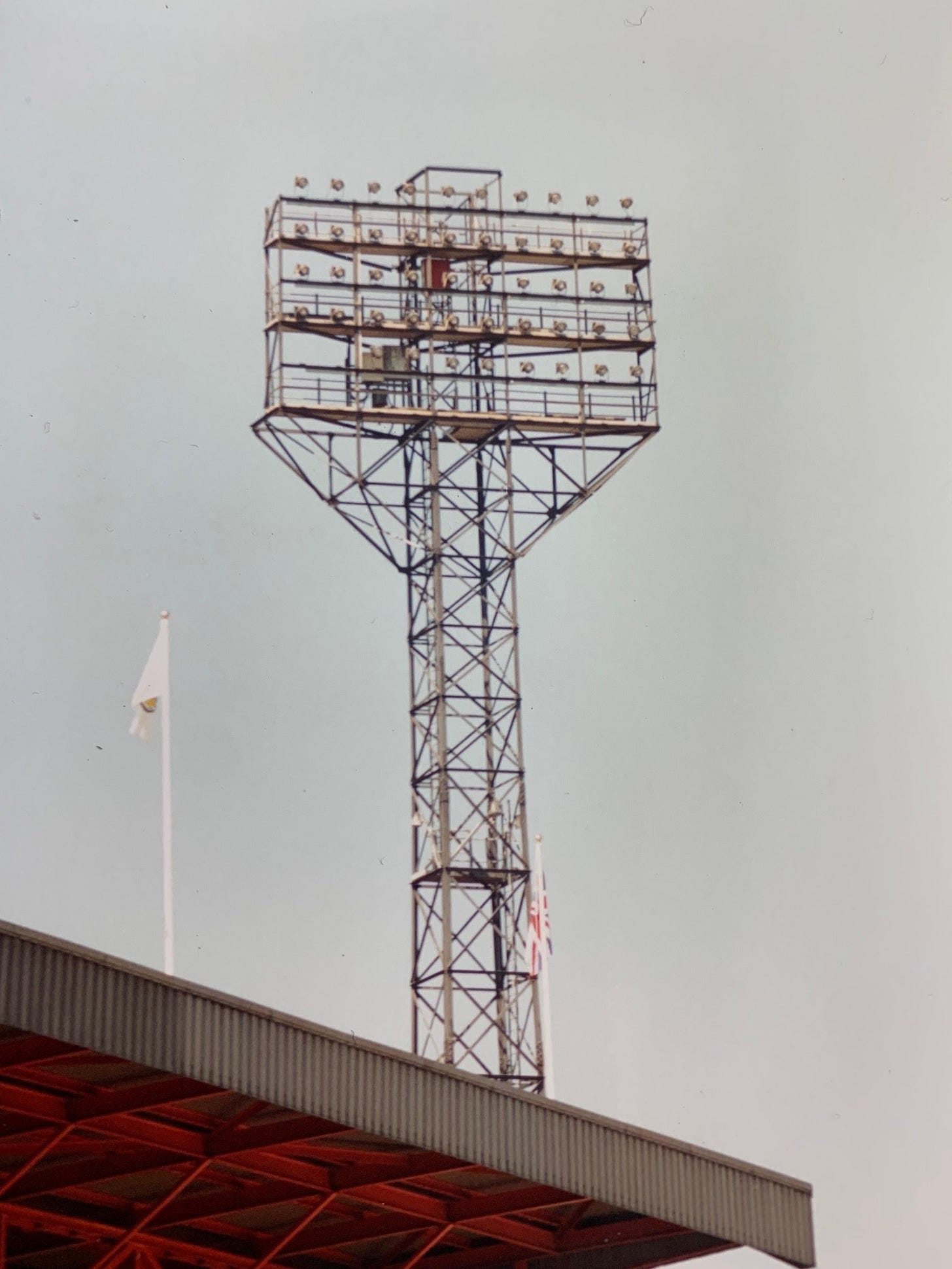
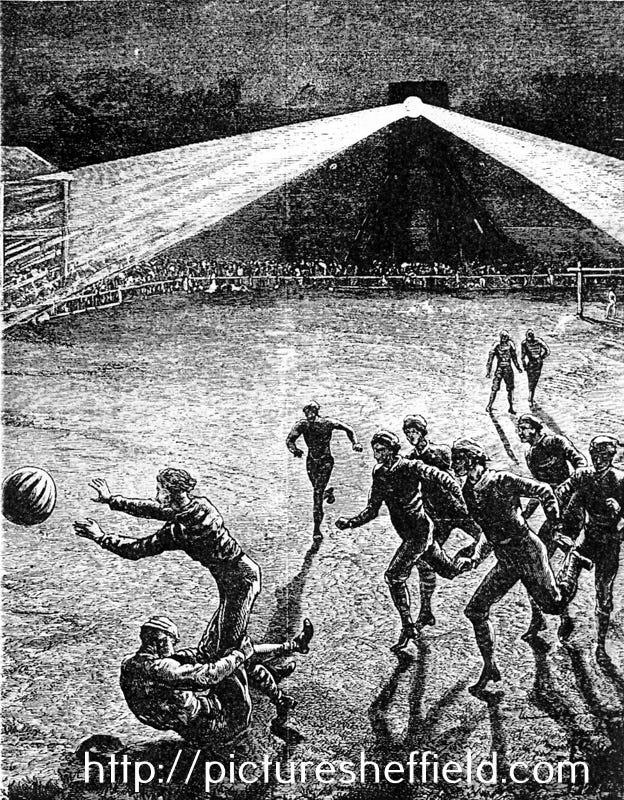
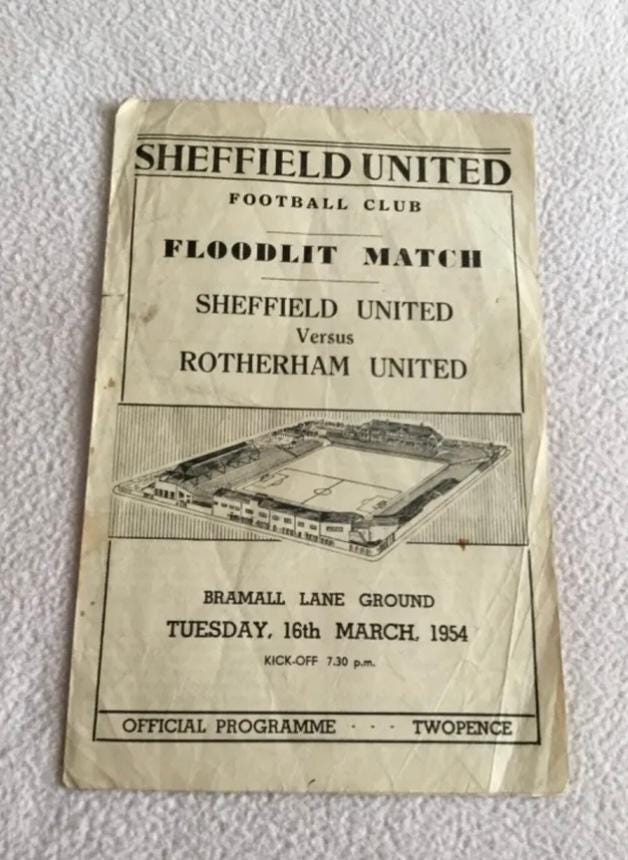
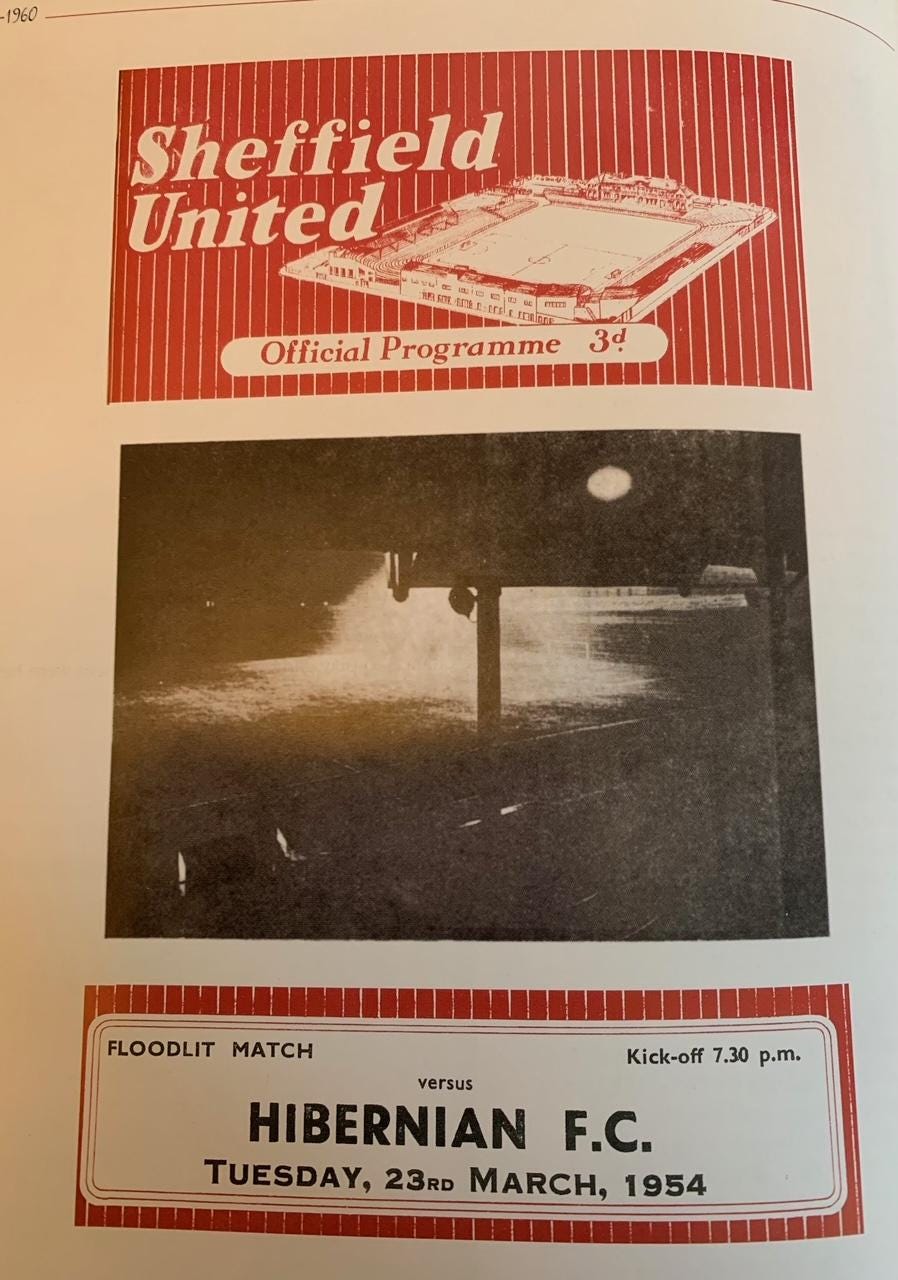
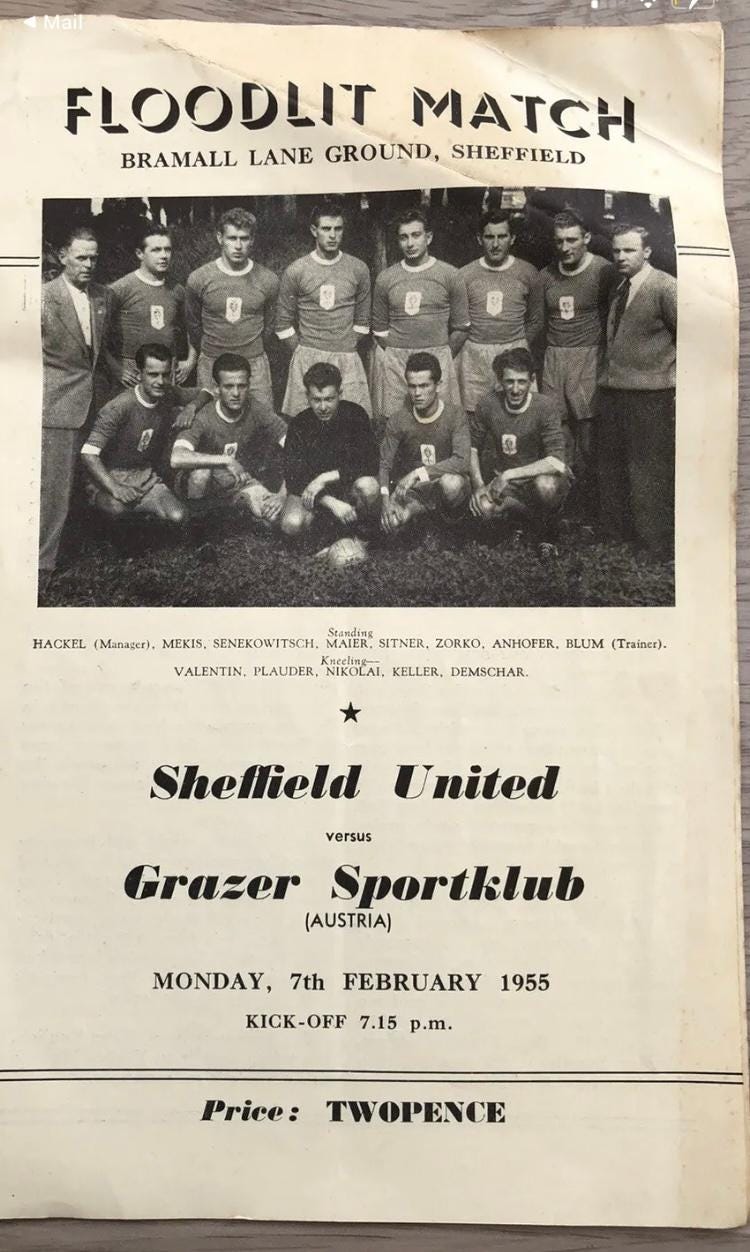
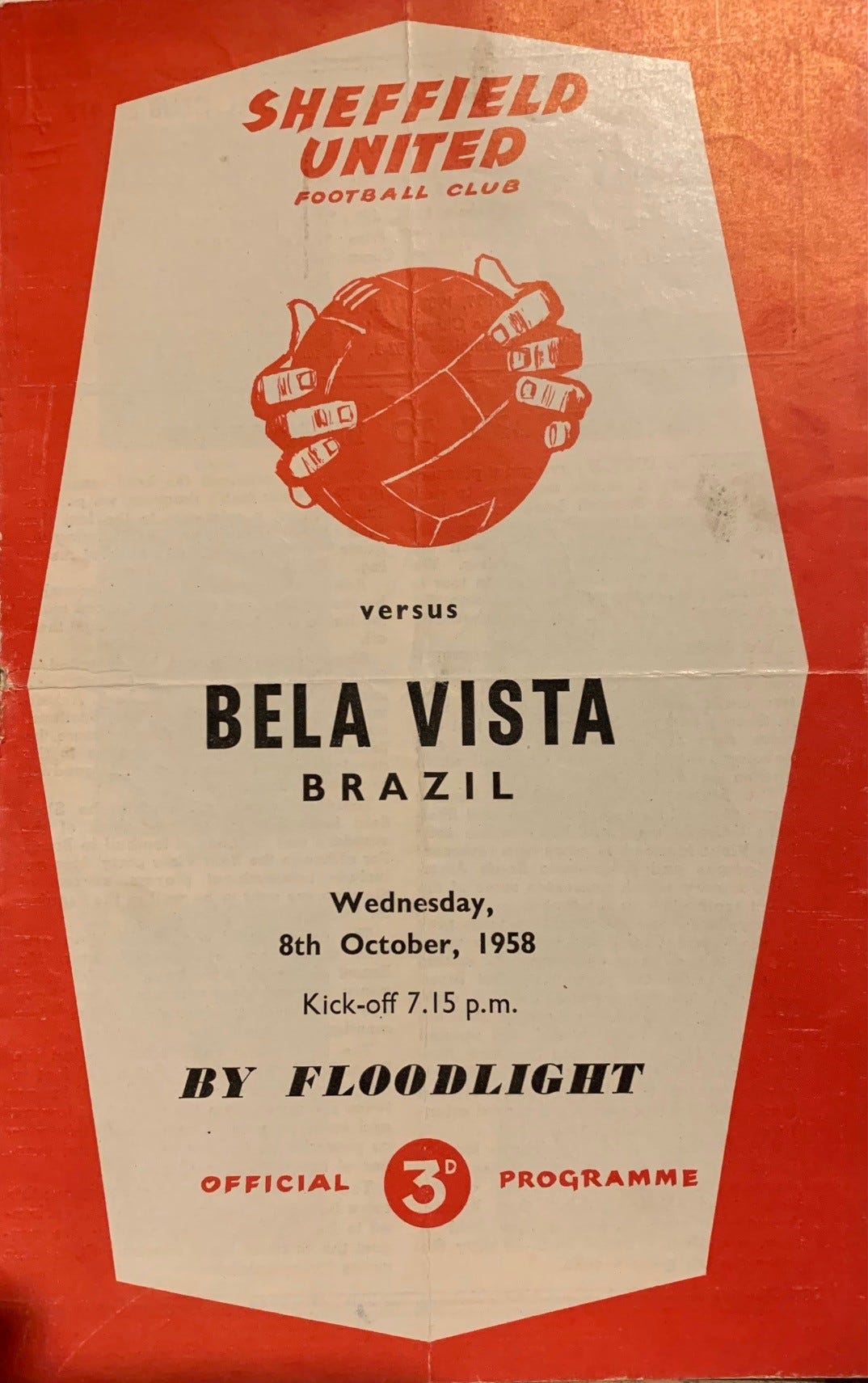
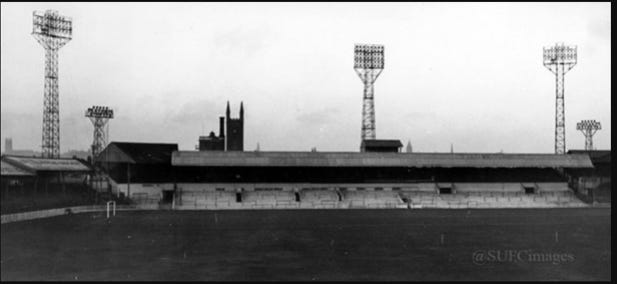
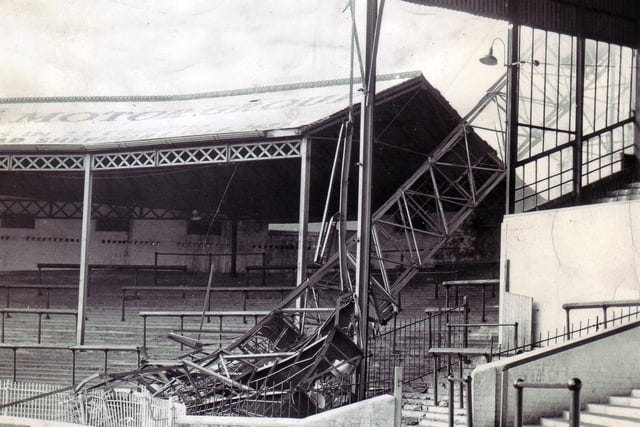
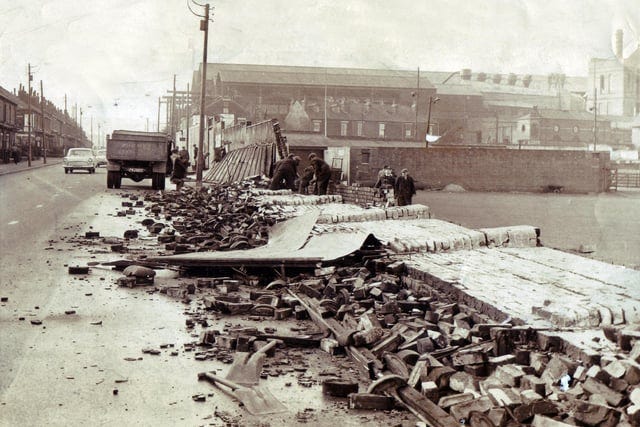
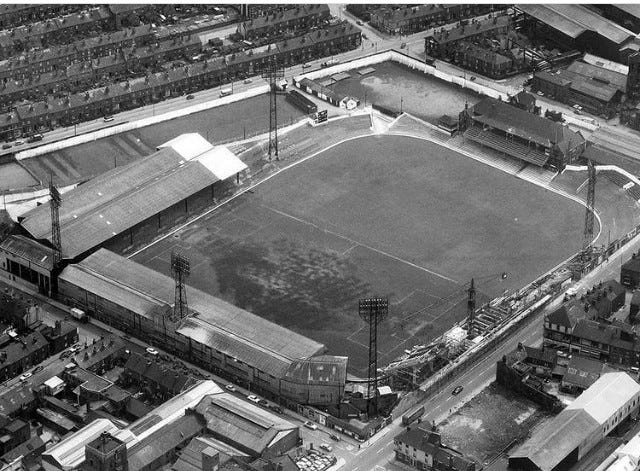
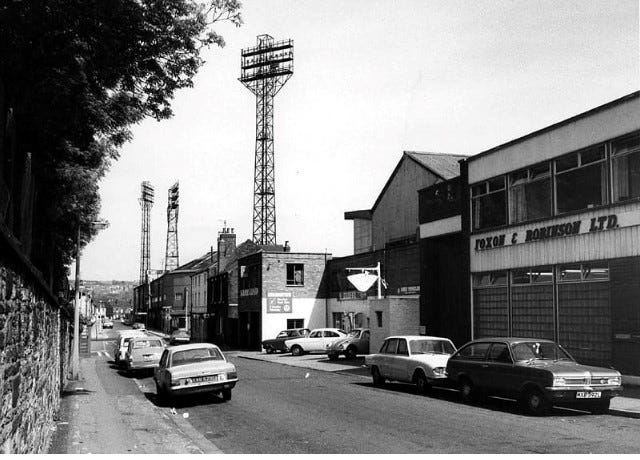
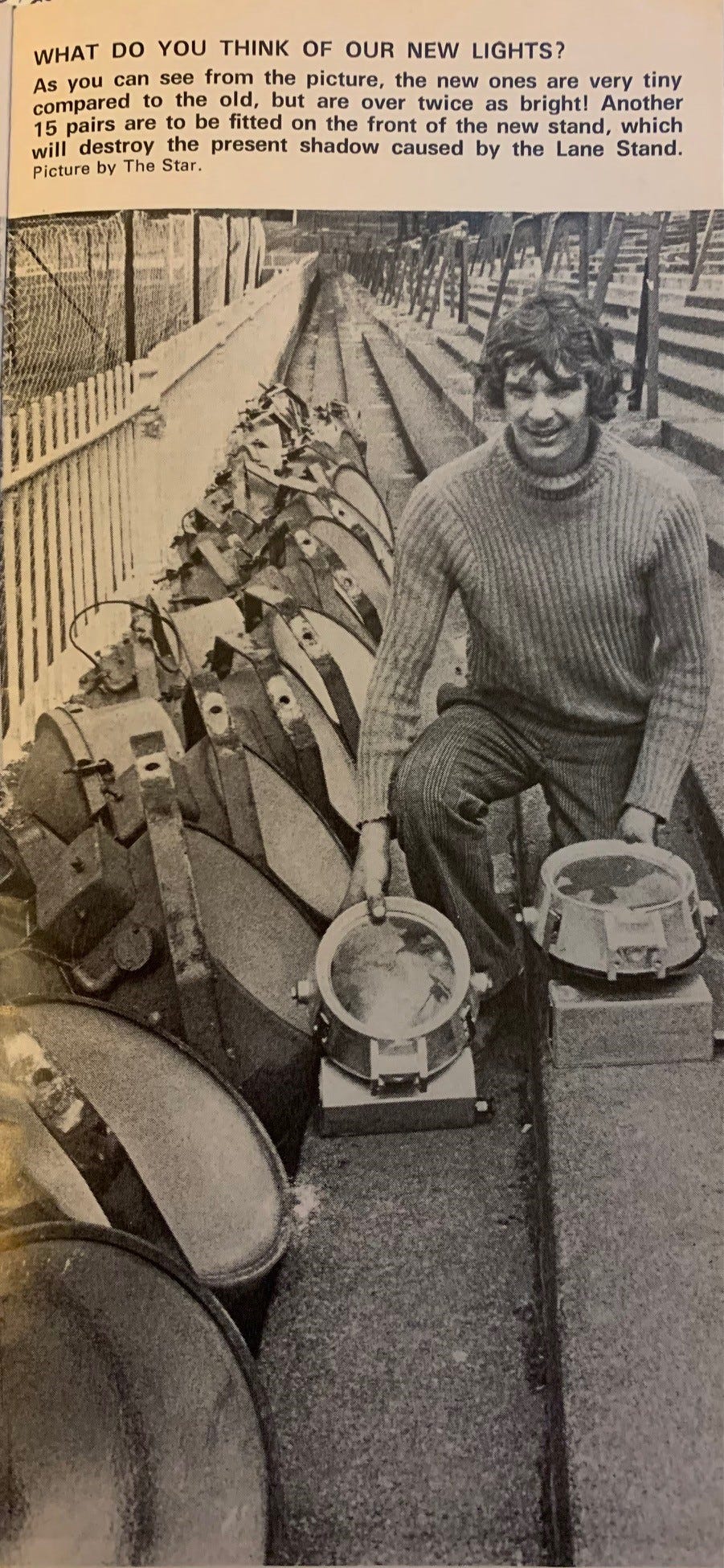
Thanks, Phil – very illuminating. (Sorry!).
I had no idea that lights had been tested as early as 1878 – what pioneers.
“In June 1955 the Football League also agreed that postponed league matches could be played under floodlights, but only if both clubs agreed.” It’s astonishing how many things football-related were either feared or derided by the “powers that be”, resisting for as long as they possibly could. But as ever, money talked! Much the same today, I suppose . . .
I worked for a firm of architects, and when we were designing a new stand for a football club I remember how precisely everything relating to floodlights had to be calculated – angles and lumen levels, consideration for neighbours and Planning Permission stating ‘no use after 10 pm’. Thankfully technology has moved on since then and with smaller lights attached to stands it’s like daylight now.
So glad Sheffield United were more forward thinking.
Sue.
PS. Loved the pics of the old programmes . . . “Programmes, 3d!!”
I too miss floodlight pylons at the Lane and other grounds. I remember being awestruck by them in the late 80s when I started to go to football. And you're right about each ground having their own pylon-personality. I am going to pinch the term "Five pylons on John Street" as the title for my no-doubt unsuccessful and unreadable autobiography. Really enjoyed this article thanks.